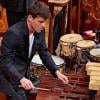
When the San Francisco Symphony presents a concert of works by two composers from 20th-century Russia, you would logically expect a certain amount of similarity in the evening. Yet, there was none of that in Davies Hall on Thursday, at the first of three subscription concerts.
Sergei Prokofiev’s 1911 Piano Concerto No. 1 and Dmitri Shostakovich’s 1941 Symphony No. 7 (“Leningrad”) might have come from different planets.The 15-minute concerto, one of the shortest in music, is a nonstop fireworks of excitement and brilliance from a 20-year-old virtuoso. Shostakovich’s 70-minute symphony is a Mahler-sized, Bruckner-like contemplation of history in slow motion.

The evening featured two notable SF Symphony debuts: conductor Karina Canellakis and pianist Alexander Gavrylyuk. Both impressed greatly.
Gavrylyuk, originally from Ukraine, has won many prestigious international competitions, lives in New York, and serves as an artist-in-residence at the Chautauqua Institution. He showed no effort in mastering the concerto’s blistering speed, pounding rhythms, and exuberant marches — misjudged by an early critic as “coarse and crude.”
The concerto’s sweeping opening sounds like a typical Beethoven finale, making one wonder where it will go from there — and it becomes even faster and bigger, with breakneck, unrelieved power.
When young Prokofiev played the concerto — at his first public performance with an orchestra — he wrote, “I have to know it by heart to play it confidently,” and so did Gavrylyuk, by necessity because reading the score and playing the solo part at the same time seems impossible. A virtuoso in every way but demeanor, the pianist is brilliant, without posturing.
The concerto does’t provide much opportunity to display the pianist’s lyrical side, so Gavrylyuk did that, beautifully, in the encore, the opening piece (“Of Foreign Lands and Peoples”) of Schumann’s Kinderszenen.

In the Prokoviev sprint and the Shostakovich marathon, Canellakis impressed equally. After graduating from Juilliard and starting her career in the second violin section of the Chicago Symphony, she has just exploded as a conductor this summer as the first woman to lead the BBC Proms’ First Night concert.
Canellakis has also started last month a four-year term as chief conductor of the Netherlands Radio Philharmonic Orchestra, where her predecessors include Bernard Haitink, Edo de Waart, and Jaap van Zweden.
Unlike conductors who vary their appearance of control, pulling back at times and letting the great engine of the orchestra run free, Canellakis uses large sweeping motions invariably to telegraph every aspect of the music. Her consistency and unflagging, visible control were especially important in maintaining focus through the sprawling, demanding “Leningrad” Symphony. Conductor and SF Symphony combined to remind me of the best performance of the work I have heard, led by James Conlon.
A dictionary example of “program music” — in the sense of “evoking images or conveying the impression of events” — the Shostakovich Seventh has a backstory and historic significance as compelling as any symphony’s. (It is also fact-based, unlike suggestions about the “meaning” of Beethoven’s “Eroica” and other works.)
To perform the Seventh in 1942 in besieged, starving, desperate Leningrad on the 335th day of the German siege which eventually claimed over a million lives required heroics unprecedented in the annals of music.
Shostakovich himself and members of the city’s Radio Orchestra had been evacuated from Leningrad — many musicians died in battle or in the siege — and soldiers who could play an instrument were ordered back from the front line to join the orchestra — and given extra rations. Reportedly, more than a dozen musicians died between the rehearsals and the concert.
Against the ravages of war, Shostakovich was also aware of another, perhaps even greater, “domestic disaster”: Stalin’s purges between 1928 and 1941 murdered at least 8 million people, with estimates as high as 20 million deaths, so the composer wrote:
“I have nothing against calling the Seventh the Leningrad, but it’s not about Leningrad under siege. It’s about the Leningrad that Stalin destroyed and that Hitler merely finished off.”
The opening of the symphony, a nearly half-hour long Allegretto, is in stark contrast with the Prokofiev concerto’s exhilaration: it is slow, deliberate, hesitating, eventually turning into an almost Haydnesque playful sound before yielding to the longest snare-drum crescendo in all music.

There are so many musicians of the orchestra shining bright in the darkness of the Seventh, but the one who should be named in the program is principal percussionist Jacob Nissly. Musically (aided by Canellakis’s overview) and physically, Nissly’s “unending” snare-drum crescendo was a wonder to behold. Shostakovich suggested that “two or three” musicians play the tattoo — growing from almost inaudible to a frightening alarm — but Nissly did it by himself, all 10 minutes of the repeated motion that’s required to build constantly.
Shostakovich said the second and third movements “are not associated with a specific program ... they are intended to serve as a lyrical respite,” and by the time the once again dramatic final Allegro arrives, orchestra and audience must meet the challenge of maintaining attention on something so lengthy and subtle.
At the beginning of the Allegro, the heroic strings and quiet timpani lay down the base not for a triumphal march, but for a stirring that’s characterized in James Keller’s program notes as “like people poking their heads out to survey what remains after a disaster.” Even the final statement of “victory” is padded by interludes of woodwind contemplations.
At the end of the 70-minute musical goliath, the orchestra had delivered an inexorable execution of a most demanding score. And, once again, kudos for Canellakis for brave programming and brilliant execution.





